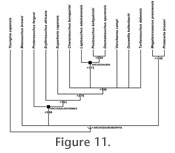|
|
|
PHYLOGENETIC ANALYSISVancleavea was placed in a matrix of 31 characters and 14 taxa to test its relationships among archosauromorphs. Included taxa (Appendix 1) are from a variety of basal archosauromorphs known from relatively complete material and included in many past phylogenetic studies (e.g., Juul 1994; Dilkes 1998; Gower and Sennikov 1997; Senter 2004). Characters were culled from several of these past studies (Appendix 2). The matrix (Appendix 3) was analyzed in PAUP* version 4.0b10 for 32-bit Microsoft Windows (Swofford 2002). The characters were unordered and of equal weight. One character (number 3) was parsimony-uninformative but was retained for use in future expansion of the matrix. Youngina capensis Broom was set as the out-group taxon, and the tree was rooted with the out-group as paraphyletic. The default settings in PAUP* for a branch and bound search were used and resulted in 15 most parsimonious trees (MPTs) with a length of 60 steps, a consistency index of .5833, a retention index of .7283, and a rescaled consistency index of .4248. Decay indices were determined using the 'keep' command in PAUP* and compiling consensus trees longer than the original consensus tree until all nodes collapsed. Bootstrap values are based on 1,000 replications.
Unambiguous synapomorphies supporting the inclusion of Vancleavea campi into Archosauriformes include the lack of post-axial intercentra, a femur with a medially inflected head, a sigmoidal femoral shaft, the lack of a distinct intertrochanteric fossa on the proximoventral surface of the femur, and the presence of osteoderms. Long and Murry (1995), unsure of its taxonomic position, originally assigned Vancleavea campi to Neodiapsida incertae sedis but suggested that it might represent an archosauromorph, whereas Small and Downs (2002) postulated that the Ghost Ranch form possessed archosauriform affinities. The current study tentatively supports these hypotheses; however, the inclusion of skull, braincase, and tarsal characters into the matrix based on the Ghost Ranch material is needed to confirm these taxonomic affinities. |
|
